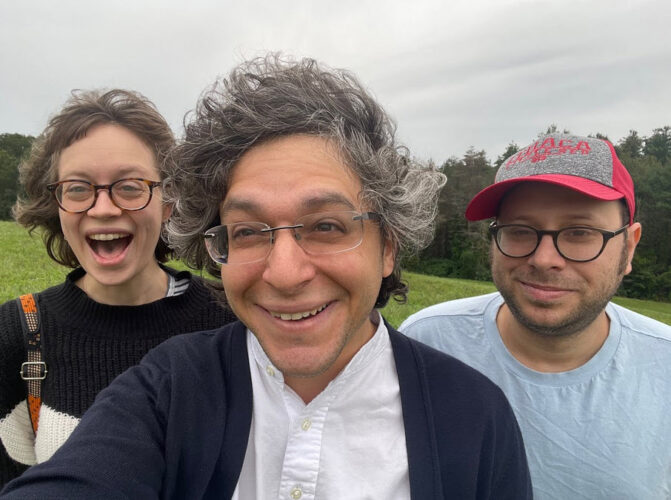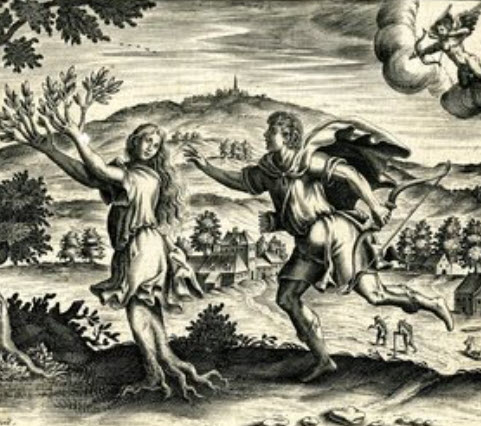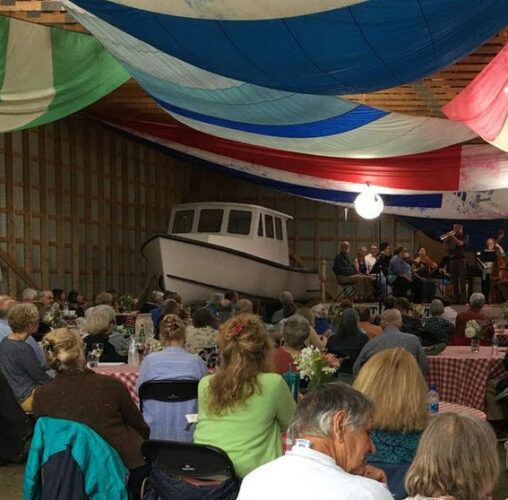by Jacob Jahiel
Published November 19, 2023
Nuova Pratica re-opens the Book on Baroque Composition

Cultural critic Frederic Jameson argues that, in an age of creative exhaustion, postmodern pastiche represents nothing more than an empty, uncritical historicism, incapable of real meaning or originality: a cannibalization of the past, parody devoid of laughter, “speech in a dead language.”
Pretty bleak stuff.
But Nuova Pratica, a group of up-and-coming performer-composers who aim to re-open the book on Baroque composition, wants you to know that the language of the past is very much alive. Formed in 2020, during the early days of the pandemic, the ensemble’s musicians write, record, and perform their own Baroque-inspired music. Rejecting the idea that what they do is mere pastiche, they don’t seek to imitate or emulate. They just want to write music they enjoy, informed by the styles and sounds they love the most.
A request for an interview with one of Nuova Pratica’s members was serendipitous: half of its ten or so members happened to be together in residence at Avaloch, an idyllic New Hampshire farm that serves as an incubator for rising artists and ensembles. The five members I spoke with — Nicola Canzano, Charlie Reed, Rafa Prendergast, Rebecca Scout Nelson, and Nathan Mondry — were at the end of a week of embarking on morning nature walks, composing, and rehearsing for an upcoming tour in the Midwest.
Like a handful of other historically informed performers who write and improvise their own music, much of their motivation comes from a desire to resurrect an important tool from the past. As cellist and viola da gambist Charlie Reed argues, “a big part of why I do this is that I see it as an extension of historical performance. Because when you look back to previous centuries, you see composers performing their music, and also improvising. They were a part of any professional musician’s skill set back in the day.”
As an academic exercise, it’s one thing — most undergraduate music students have probably had to write a few measures of a fugue à la Bach. But as an artistic endeavor, it’s entirely another, and a brief glance at the 20-odd videos the ensemble has produced in recent years show a body of work that is fresh, varied, and imaginative:
Nicola Canzano’s Trio Sonata in A minor, Allemande & Gigue:
Rebecca Scout Nelson’s Consolations I, II, & III:
Nuova Pratica’s music also issues an unspoken challenge to the idea that everything has already been said in the musical language of the Baroque. Whether faced with a Corrente that seems to come directly out of a 17th-century dance suite, or just something imbued with characteristic Baroque flavors, audiences have proved receptive — although some people need more convincing than others.
So how does Nuova Pratica respond to the idea that there is already enough Baroque music, and that they are merely resurrecting ghosts of the past?
“I’ve basically been preparing to answer this question my whole life,” says harpsichordist Nicola Canzano, one of the group’s founders. “I would tell them that they’ve been poisoned, completely misguided by this idea that musical style is linear and progressive. It doesn’t operate that way, it’s like fashion.”
It’s true: We are collectively burdened with a mythology that music history consists of a series of stylistic or technical “advancements.” Although it’s no longer universally accepted in academia — and never was in the early-music world — it’s a perception with a lot of staying power. There are myriad reasons. For one, there’s the simple fact that we tend to understand the world in a linear fashion: We write our histories from the past to the present, and it’s easy to conflate development with progress.
‘They’ve been poisoned, completely misguided by this idea that musical style is linear and progressive.’
But the ideology of musical progress became particularly virulent with the 19th-century canonization of Haydn, Mozart, and Beethoven, a process inextricably tied with the birth of historical musicology as a discipline. “Ironically, [musical progress] is kind of a Victorian way to think about style,” says keyboard player and co-founder Nathan Mondry, who’s known Canzano since they were seven years old.
“It’s kind of an alternate type of archeology,” Mondry continues. “But we’re not just digging up some old bones, we have some real bodies. We get to have the experience of what it’s like to play music where the ink is still drying.”
Nathan Mondry’s “Mi chamocha”:
Most historical performers have dreamt of being in the same room as their favorite composers — “tell me, Mr Rameau, what ornament would you use here?” For Nuova Pratica’s members, the ultimate resource lies only a few feet away. “In the early-music revival, there’s an idea of bringing music back to life,” says violinist Rafa Prendergast. “And it already feels very lively to be playing this music. So when we’re playing music by people in the room with us, it’s extremely lively. It just has this kind of vitality to it, it adds a different layer.”
It’s safe to say that Nuova Pratica’s members are the leading authorities on interpreting each other’s music. Prendergast explains, “generally, we shift how we play in the early-music world depending on what style you’re playing in, but in this way it feels very specific. We know how to get inside of each other’s pieces, and bring our previous knowledge of each other’s pieces into what we are playing. It’s cool how specific we get to be. And if someone tries something new, it’s not new out of context — it’s something within the context of that person.
A typical rehearsal also entails work-shopping each other’s compositions. While Nuova Pratica’s members compose individually, they regularly solicit comments or feedback for works-in-progress.
It’s a process that requires diplomacy and sensitivity but, according to violinist, vocalist, and songwriter Rebecca Scout Nelson, “I think we all have a sense of each other’s style, and try to keep comments to what we know works within the language of that person’s writing style, as opposed to applying our own opinions, or just applying a style that is generally Baroque. My music goes a little more in the folk-y direction, I break some rules that maybe Couperin wouldn’t have appreciated. But everyone here is really sensitive to that, recognizing ‘in your world, this makes sense.’”
Rebecca Scout Nelson’s “Chocolate”:
Each member has a different process for arriving at a particular style, and that process may change from piece to piece. In some cases, close study of a particular composer or piece might inform a composition; other times there is more reliance on intuition. For Reed, “not always, but often when I write a piece, I have specific models in mind, specific composers. For example, the piece I brought this week is a trio for flute, gamba, and continuo. And I was definitely thinking about Telemann when I composed it. Other times, I have written suites for solo viol and continuo, and there I was looking at specific pieces by composers like Marin Marais.”
Charles Reed’s Prelude and Fugue for Viol and Cello:
Similarly, Mondry says, “sometimes if a motive comes to mind, and I’m able to identify something about it that is concrete, with implications that come with it. Other times, I’m listening to a certain kind of music for a couple weeks, and that’s just in the air. So that inspires me in a different way.”
Nuova Pratica’s members don’t worry that their music will be derivative or unoriginal because their primary goal isn’t to try to emulate anyone or anything. Nor do they seem to be burdened by expectations of radical originality they perceive in the composition world at large.

Canzano argues that “when we ask modern composers this question — how we arrive at a style — it will almost always involve some mention of individuality or originality or finding a voice or something like that. I feel that the search for originality is one of the most misguided things of our time because it’s basically inevitable…. If you write the music you like, you will eventually arrive at a style you like as long as you are true to finding out the things that make you tick.” (As Jean Cocteau once remarked: An original artist can’t help but be original, therefore he need only copy.)
Nelson likens her process to passages in Walt Whitman’s Leaves of Grass: “Whitman talks about how he is everything that surrounds him: We are our parents, we are our friends, we are the nature we are surrounded by, we are New York City. We are the music we listen to. For me it’s impossible to separate myself from what I consume and who I am around. I’m constantly bouncing off that.”
“At the end of the day,” Nelson continues while gesturing to her head, “it all trickles through my sponge self, and the final product when I create something is still my own, my interpretation of the world, no matter what. I cherish that outcome, but I don’t deny that it is all of the wonderful things that are happening around me, especially listening to music I love.”
Jacob Jahiel is a writer, editor, and viola da gambist living in Baltimore. For EMA, he recently reviewed Reginald Mobley’s Spirituals album, ‘Because.’




